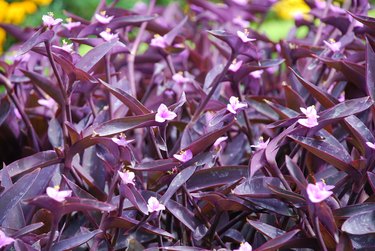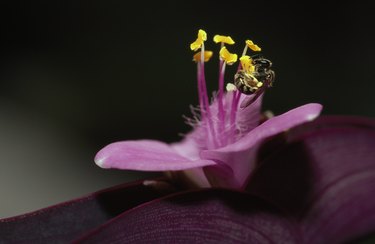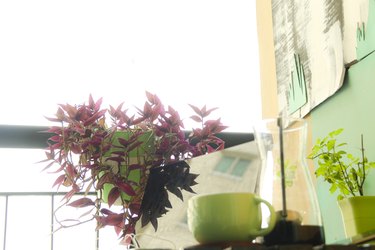
If you want to gift a friend or family member with a cutting from one of your plants, then purple heart (Tradescantia pallida) is one you should consider. Not only is it visually striking with its beautiful purple foliage but it's one of the easiest houseplants to propagate even if you're a beginner. It's also a durable, drought-tolerant plant that thrives on neglect, so your friend won't need to be an expert gardener to keep it alive. It can be used outdoors as a tender perennial in USDA plant hardiness zones 7-10, bringing a touch of vivid color to otherwise green beds.
About Purple Heart Plants
Video of the Day

Purple heart is a part of the larger spiderwort family, which includes both temperate and tropical/semitropical plants with similar growth habits. In its native Mexico, it's an evergreen perennial that's often used as a ground cover, but its susceptibility to cold limits its outdoor usage in the United States to a handful of the warmest climates.
Video of the Day
Instead, it's primarily grown as a houseplant, where its purple leaves, which can be up to 7 in. long, bring dramatic, year-round color to any room. It will grow in full sun or partial shade, so you (and your friend) will have some flexibility when considering where to position the plant for best effect. Its color will be most vivid in full sun; leaves will be greener in the shade.
Indoors, you can maximize your purple heart's impact by planting multiple stems in the same pot to create a fuller effect and by pinching stem tips so stems will fork and become bushier. It works well in a hanging basket or planter on any surface where the plant can spread and tumble. Outdoors, purple heart shows best when planted in large clumps to create a solid block of color. Unfortunately, its eagerness to grow from cuttings means it's considered invasive in some areas, so check with local authorities before planting.
What's In a Name?
You’ll most often see these plants described in nurseries as simply Tradescantia pallida, though other variations (Tradescantia pallida ‘Purple Heart,’ Tradescantia pallida ‘Purpurea’ or the older Setcreasea pallida) are sometimes used. You might also see it referred to as Purple Secretia or Purple Queen.
How to Propagate Purple Heart Plants

Purple heart propagates easily from leaf or stem cuttings. (Any part of the plant will work, but those are easiest.) One option is to place your cutting in a glass of water, watching until it begins to grow roots, and then transplanting it into good-quality potting soil. Another option is to simply place the cutting directly into soil, where it will almost invariably root.
If you're new to houseplant propagation, you might want to root your cutting in water simply because watching roots form will give you some peace of mind and assurance that things are happening as they should. Similarly, while you don't need to use rooting hormone with a cutting of purple heart, it won't hurt and can provide added confidence. If you plant cuttings in soil, water them lightly but frequently.
It's also possible to propagate purple heart from seed, but this isn't usually done. Seeds are rare and hard to find because the plant is so easily grown from cuttings, so your only source will usually be the blossoms on your own plants.
Preparing Purple Heart Plants for Gifting

Once cuttings are potted and showing new growth, they're ready for gifting. This is where things get interesting because each scenario is different. If your friend casually requested a cutting in passing, you probably won't need to be especially formal about it. If you send along an established, rooted cutting or two in a disposable pot with good soil, you've done all you really need to do. Similarly, if your friend intends to plant cuttings outside, sending along a dozen or so in seedling trays or disposable cups (early in the growing season, ideally) is perfectly appropriate.
If your gift is more formal—perhaps as a housewarming gift for someone who is notoriously inept with indoor plants—you might choose to take more trouble. In this case, invest time to grow out cuttings for an extra month or two so the plant has a full and lavish appearance from the start. Choose an attractive planter, one that adds to the plant's visual appeal. A planter that will stand on a surface could be decorated with a ribbon or bow, while a hanging plant can be complemented by a decorative hanger or perhaps (depending on your friend's taste and decor) something whimsical, like battery-operated twinkle lights.
Purple Heart Plant Care
A thoughtful touch, especially if your friend isn't experienced, is to provide care instructions along with the plant or cutting. In casual scenarios, this could come in the form of a link or email, but for a formal gift, you should consider printing written instructions on attractive card stock. You can touch on things like:
- Watering instructions (light but frequent watering)
- Repotting (choose a pot with drainage holes and wear gloves to avoid skin irritation)
- Preferred soil (a potting mix with lots of perlite or vermiculite to promote drainage)
- Location tips (direct sunlight)
- Common pests (mealybugs, scale, aphids, spider mites, vine weevils and sometimes caterpillars or snails if outdoors)
- Need for fertilization (lightly once a month or so while actively growing)
And, of course, you can include instructions for propagating more plants should they wish to establish additional pots or gift their friends in turn. What a beautiful way to pay it forward!